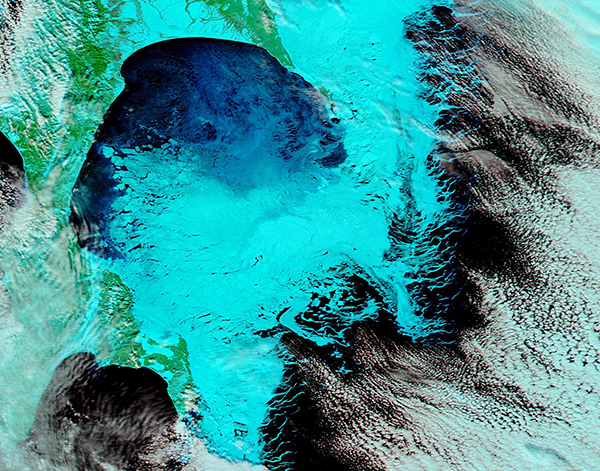Images
February 4, 2022 - Sea Ice off Sakhalin Island
Tweet
Frigid temperatures across Russia’s Far East helped sea ice form and thicken on the Sea of Okhotsk off the coast of Sakhalin Island by early February 2022. Although sea ice forms across most of the area above the Arctic Circle each winter, seas near and south of that landmark can also become frosted in ice. The Sea of Okhotsk is one of the lowest latitudes in the Northern Hemisphere (about 44˚N) where substantial amounts of sea ice can be expected each year. This winter, satellite imagery showed light ice beginning to form in mid-December and thickening through early February.
The Moderate Resolution Imaging Spectroradiometer (MODIS) on board NASA’s Aqua satellite acquired a stunning false-color image of sea ice east of Sakhalin Island on February 2. This type of image, using near-infrared and visible light, is especially helpful to separate snow (bright electric blue) from cloud (white or very light blue when ice crystals are present in the cloud). Deep water appears black, and vegetation looks green. Where sea ice is thin and moist, it often appears in various tones of blue depending on the moisture content. This view shows that ice has begun to cling to the eastern-most shores of the curved island, both in the north and south, to create a frigid bridge between. Open water remains between this bridge and the more westward-lying edge of Sakhalin Island.
Image Facts
Satellite:
Aqua
Date Acquired: 2/2/3033
Resolutions:
1km (432.9 KB), 500m (1.1 MB), 250m (735.6 KB)
Bands Used: 7,2,1
Image Credit:
MODIS Land Rapid Response Team, NASA GSFC
Tweet
Frigid temperatures across Russia’s Far East helped sea ice form and thicken on the Sea of Okhotsk off the coast of Sakhalin Island by early February 2022. Although sea ice forms across most of the area above the Arctic Circle each winter, seas near and south of that landmark can also become frosted in ice. The Sea of Okhotsk is one of the lowest latitudes in the Northern Hemisphere (about 44˚N) where substantial amounts of sea ice can be expected each year. This winter, satellite imagery showed light ice beginning to form in mid-December and thickening through early February.
The Moderate Resolution Imaging Spectroradiometer (MODIS) on board NASA’s Aqua satellite acquired a stunning false-color image of sea ice east of Sakhalin Island on February 2. This type of image, using near-infrared and visible light, is especially helpful to separate snow (bright electric blue) from cloud (white or very light blue when ice crystals are present in the cloud). Deep water appears black, and vegetation looks green. Where sea ice is thin and moist, it often appears in various tones of blue depending on the moisture content. This view shows that ice has begun to cling to the eastern-most shores of the curved island, both in the north and south, to create a frigid bridge between. Open water remains between this bridge and the more westward-lying edge of Sakhalin Island.
Image Facts
Satellite:
Aqua
Date Acquired: 2/2/3033
Resolutions:
1km (432.9 KB), 500m (1.1 MB), 250m (735.6 KB)
Bands Used: 7,2,1
Image Credit:
MODIS Land Rapid Response Team, NASA GSFC




